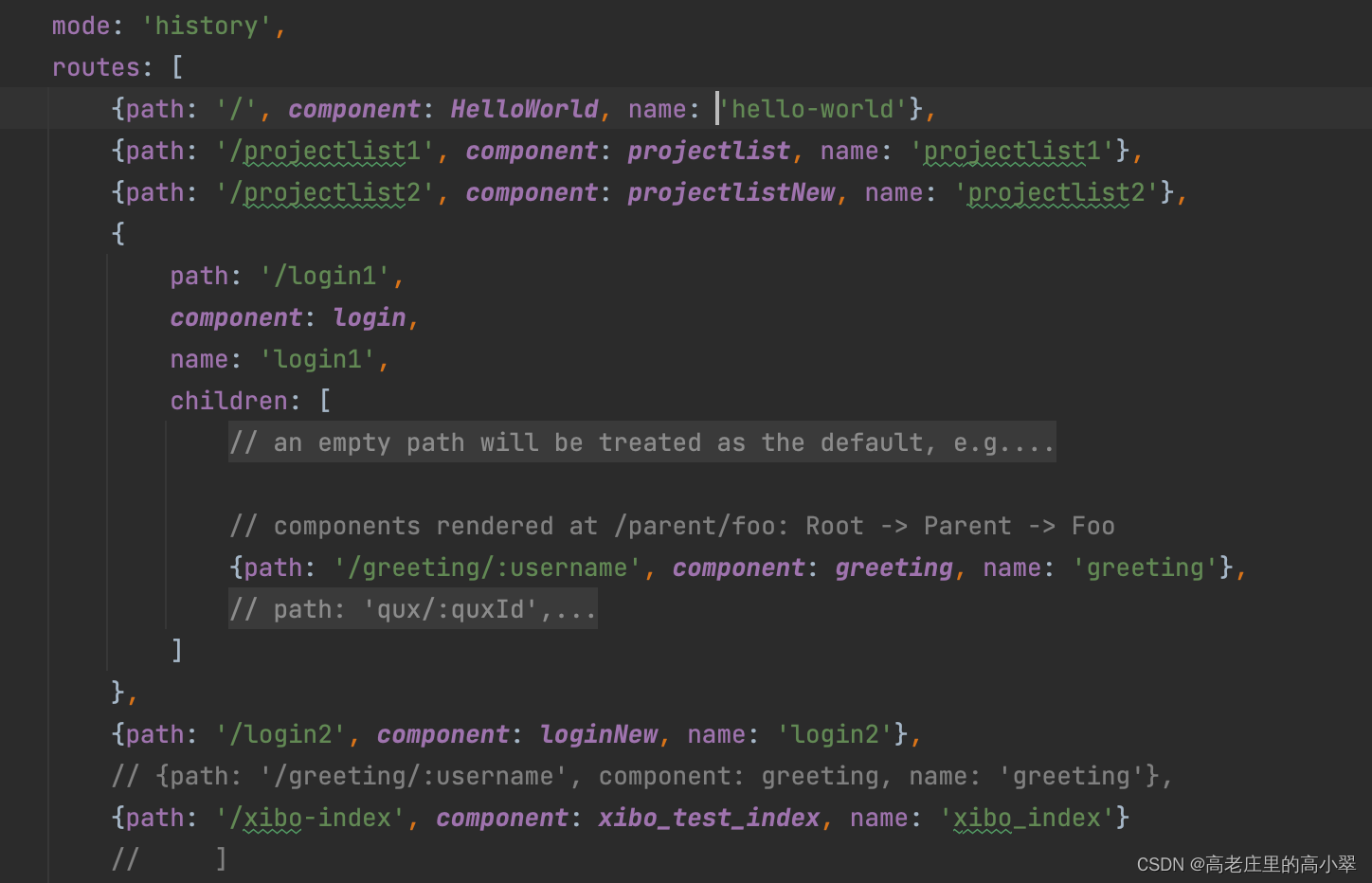【vue】vue中的插槽以及使用方法
插槽
普通插槽
1、在父组件中直接调用子组件的标签,是可以渲染出子组件的内容;如果在子组件标签中添加了内容,父组件就渲染不出来了;
ParentComponent.vue:
<template><div><h1>Parent Component</h1><child-component><p>This is custom content inside the child component.</p></child-component></div>
</template><script>
import ChildComponent from './ChildComponent.vue';export default {name: 'ParentComponent',components: {ChildComponent}
};
</script>
无名插槽(默认插槽)
ChildComponent.vue:
<!-- 第一种方式-->
<template><div><h2>Child Component</h2><slot></slot><p>This is content from the child component.</p></div>
</template><script>
export default {name: 'ChildComponent'
};
</script>2、如果父组件调用的子组件标签中和子组件中的插槽中都有文本内容,那么父组件中的会覆盖子组件插槽中的内容;
<!-- 第二种方式-->
<template><div><h2>Child Component</h2><slot><p>我们一起学猫叫</p></slot><p>This is content from the child component.</p></div>
</template><script>
export default {name: 'ChildComponent'
};
</script>在上述示例中,
ChildComponent组件使用了一个无名插槽(默认插槽)。在ParentComponent中,通过将内容包裹在<child-component>标签中,该内容就会被插入到ChildComponent的插槽中。
index.js

以父组件为loginnew,子组件为hello-world为例;
<!--父组件loginnew.vue->>
<hello-world></hello-world>
<hello-world>这是个hello-world插槽位</hello-world>
<!--如果想要渲染出父组件中调用子组件标签中的内容,就要在子组件中添加插槽-->
<!--子组件hello-world.vue文件-->
<!--如果父组件调用的子组件标签中和子组件中的插槽中都有文本内容,那么父组件中的会覆盖子组件插槽中的内容-->
<slot><p>hello-world:我们一起学猫叫</p></slot>具名/命名插槽
是 Vue.js 组件中的一种高级插槽技术,允许您在组件中定义多个具有名称的插槽,以便更精细地控制不同部分的内容插入位置。通过使用具名插槽,您可以在父组件中传递不同的内容到不同的插槽位置,从而实现更灵活和定制化的布局和组件复用。
以下是一个使用具名插槽的示例:
ChildComponent.vue:
<template><div><h2>Child Component</h2><slot name="header"></slot><slot></slot><slot name="footer"></slot></div>
</template><script>
export default {name: 'ChildComponent'
};
</script>
ParentComponent.vue:
<template><div><h1>Parent Component</h1><child-component><template v-slot:header><p>This is the header content.</p></template><p>This is the main content.</p><template v-slot:footer><p>This is the footer content.</p></template></child-component></div>
</template><script>
import ChildComponent from './ChildComponent.vue';export default {name: 'ParentComponent',components: {ChildComponent}
};
</script>
在上述示例中,
ChildComponent组件定义了三个插槽,分别是默认插槽以及具名插槽header和footer。在ParentComponent中,使用<template>元素配合v-slot指令来填充具名插槽的内容。注意,Vue 2.6.0 及以上版本引入了新的缩写语法,将
v-slot:header缩写为#header,这样可以更简洁地使用具名插槽。示例中的
ParentComponent会渲染成如下内容:
<div><h1>Parent Component</h1><div><h2>Child Component</h2><p>This is the header content.</p><p>This is the main content.</p><p>This is the footer content.</p></div>
</div>
通过使用具名插槽,您可以在不同的插槽位置插入不同的内容,从而实现更灵活和可配置的组件。具名插槽使得您的组件能够更好地适应各种不同的使用场景。
父组件loginNew.vue:
<template><div><el-form :model="ruleForm" status-icon ref="ruleForm" label-width="70px" class="demo-ruleForm":label-position="labelPosition"><el-form-item label="用户名" prop="username"><el-input type="username" v-model="ruleForm.username" autocomplete="off"></el-input></el-form-item><el-form-item label="密码" prop="password"><el-input type="password" v-model="ruleForm.password" autocomplete="off"></el-input></el-form-item><el-form-item><el-button type="primary" @click="submitForm('ruleForm')">提交</el-button><el-button @click="resetForm('ruleForm')">重置</el-button></el-form-item></el-form><!-- 如果父组件调用的子组件标签中和子组件中的插槽中都有文本内容,那么父组件中的会覆盖子组件插槽中的内容--><!-- <hello-world>这是个hello-world插槽位</hello-world>--><!-- 如果父组件调用的子组件标签中和子组件中的插槽中都有文本内容,那么父组件中的会覆盖子组件插槽中的内容--><!-- <hello-world></hello-world>--><hello-world><!-- 方法二 命名插槽--><!-- 在vue2.6之前版本--><p slot="part1">一起喵喵喵</p><!-- 在vue2.6之后版本--><template v-slot:part2><p>在你面前撒个娇</p></template><!-- v-slot:可以简写成"#" --><template #part3><p>还是喵喵喵喵</p></template><!-- 插槽作用域:父组件调取子组件的插槽内部要获取子组件的属性--><!-- 2.6 之前--><p slot="part4" slot-scope="scope">{{ scope.user }}我得心脏砰砰跳</p><template slot="part5" slot-scope="scope"><p>{{ scope.user }}我得心脏砰砰跳aaaaaa</p></template><!-- 2.6 之后--><template v-slot:part6="scope"><p>{{scope.user}}都是你的味道</p></template><template v-slot:part7="{user}"><p>{{user}}都是你的味道</p></template></hello-world></div>
</template><script>
export default {name: "loginNew",data() {return {username: "daxiao",password: "123456",labelPosition: "right",ruleForm: {username: "111",password: "222",}}},
}
</script><style scoped>
.el-form {width: 350px;margin: 50px auto;
}
</style>子组件HelloWorld.vue:
<template><div class="hello"><h1>{{ msg }}</h1><h>{{ msg1 }}</h><p>这是一个hello-world页面</p><div><el-imagestyle="width: 300px; height: 200px":src="url"fit="cover"></el-image></div><!-- 第一种方式--><!-- <slot></slot>--><!-- 第二种方式--><slot><p>我们一起学猫叫</p></slot><!-- 第三种方式 命名插槽--><slot name="part1"></slot><slot name="part2"></slot><slot name="part3"></slot><!-- 插槽作用域--><slot name="part4" :user="username"></slot><slot name="part5" user="六啊"></slot><slot name="part6" user="七啊"></slot><slot name="part7" user="八啊"></slot><!-- <slot ></slot>--></div>
</template><script>
// import axios from 'axios';
import {dogs} from '../api/api'export default {name: 'HelloWorld',props: {msg: String},data() {return {url: '',username: "木子"}},mounted() {//方法一:不推荐// axios.get('https://dog.ceo/api/breeds/image/random')// //如果请求成功,就会执行.then回调函数// .then(function (response) {// console.log('data:',response.data)// console.log('response:',response)// //此时的this指的是当前函数的应用// this.url=response.data.message// })// //如果请求失败,就会执行.catch回调函数// .catch(function (err) {// console.log(err)// });// axios.get('https://dog.ceo/api/breeds/image/random')// //如果请求成功,就会执行.then回调函数// //方法二:使用箭头函数// .then(response => {// console.log('data:', response.data)// console.log('response:', response)// //此时的this指的是当前函数的应用// this.url = response.data.message// })// //如果请求失败,就会执行.catch回调函数// .catch(function (err) {// console.log(err)// });dogs()//如果请求成功,就会执行.then回调函数//方法二:使用箭头函数.then(response => {console.log('data:', response.data)console.log('response:', response)//此时的this指的是当前函数的应用this.url = response.data.message})//如果请求失败,就会执行.catch回调函数.catch(function (err) {console.log(err)});}
}</script><!-- Add "scoped" attribute to limit CSS to this component only -->
<style scoped></style>作用域插槽
是 Vue.js 组件中一种高级插槽技术,它允许父组件向子组件传递数据,并在子组件中根据这些数据自定义渲染逻辑。作用域插槽允许子组件对传递的数据进行更灵活的处理和展示,从而实现更高级的定制。
作用域插槽适用于以下情况:
- 当父组件需要向子组件传递数据,以在子组件内部进行渲染和处理。
- 当子组件需要在不同的上下文中使用传递的数据,例如在列表渲染或嵌套组件中。
以下是一个使用作用域插槽的示例:
List.vue:
<template><div><ul><li v-for="(item, index) in items" :key="item.id"><slot :item="item" :index="index"></slot></li></ul></div>
</template><script>
export default {name: 'List',props: {items: Array}
};
</script>
ParentComponent.vue:
<template><div><h1>Parent Component</h1><list :items="dataItems"><template v-slot="slotProps"><p>Item {{ slotProps.index }}: {{ slotProps.item.name }}</p></template></list></div>
</template><script>
import List from './List.vue';export default {name: 'ParentComponent',components: {List},data() {return {dataItems: [{ id: 1, name: 'Item 1' },{ id: 2, name: 'Item 2' },{ id: 3, name: 'Item 3' }]};}
};
</script>
在上述示例中,
List组件使用作用域插槽将每个列表项的数据和索引传递给插槽内容。在ParentComponent中,通过<template>元素使用v-slot缩写来定义作用域插槽,并在插槽内部使用传递的数据进行渲染。作用域插槽的特点是,它将子组件内部的渲染逻辑交由父组件控制,子组件只需要关心数据的展示。这样可以实现更大程度的组件复用和定制。
作用域插槽是 Vue.js 中非常强大和有用的特性,能够使您的组件更加灵活和高效
